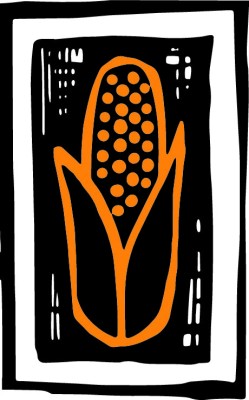
The story behind Cope’s dried sweet corn
Four hundred years ago, amongst the wild turkey, venison, cod, and bass, the original Thanksgiving table included corn. Not fresh corn on the cob. Since the corn harvest ended by early fall and flash freezing hadn’t quite been invented yet, back then any corn eaten in November would have been dried. Much of the dried corn was ground into meal for bread or stews. But some of it was left in whole kernels and served as a dish we know now as creamed corn.
For the next three centuries, dried corn remained a staple in kitchens across the US. But in the early 1900s with the rise of canning, and then frozen foods, dried corn became a thing of the past. Today, almost no one dries corn commercially—except for Cope’s.
Martin Cope dried his first batch of corn on a coal-burning stove in 1900.
Today the company he started is working on a slightly larger scale, but the flavor still has that stovetop toasted quality. From July to October, sweet corn is trucked from across the mid-Atlantic region to Cope’s factory in the town of Rheems, deep in Pennsylvania Dutch country. They use corn varieties like Silver Queen that are known for their exceptional sweetness. The kernels are cut from the cob and thousand-pound batches are roasted at a low temperature for about eight hours. During most of the cooking time, employees work 24 hours a day turning the corn with big yellow plastic shovels to help it cook evenly. All that work pays off. The slow, even cooking caramelizes the corn, accentuating its sweetness while giving it a nutty, rich flavor. Their last step is to crack the corn into smaller pieces which makes for quicker cooking at home.
I haven’t had the chance to visit Cope’s yet, but the late R.W. Apple, long-time editor and writer at The New York Times, described the scene at the end of the production so well we can all imagine ourselves there: “the corn falls into boxes to await packaging and shipment. It makes a splendid visual and olfactory spectacle, the pieces glowing like bits of amber or burnished old gold and giving off a smell so tantalizingly sweet that I thought [my wife] Betsey would dive right in.”
Cope’s dried corn is a perfect fit for the Thanksgiving table.
Even if you’re not interested in the historical links between this corn and the first Thanksgiving, this is just plain good eating. A batch of Cope’s corn is a crowd pleaser—adults love it, and kids go crazy for it. It’s no wonder. It has the toasty-yet-bright flavor of roasted summer corn. It’s so good that you’d even want to eat it when summer corn is at its best. Simmer some into a corn chowder. Bake some in a casserole. Or serve it the classic way: as creamed corn.

Zingerman’s Roadhouse creamed corn recipe
Serves 4-5
Ingredients
2 3.75 oz pouch of Cope’s dried sweet corn
3 ½ cups boiling water
3 teaspoons sugar
1-2 tablespoons of butter
pinch of salt
½ cup cream
Method
1. In a saucepan, combine Cope’s dried corn with the 3 ½ cups of boiling water. Let soak for 2 hours.
2. Add 3 tsp sugar, 1-2 tbsp butter, and salt to taste, then set the pan on the stove. Bring to a simmer and let it cook over low heat for half an hour or longer, stirring occasionally.
3. Just like with polenta, the longer you let it cook, the better it tastes.
4. Add ½ cup cream and continue to cook for another five minutes